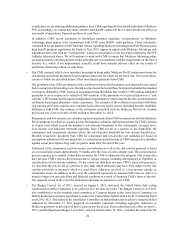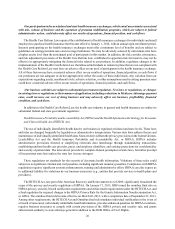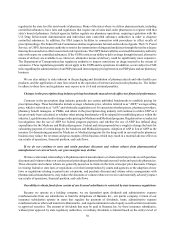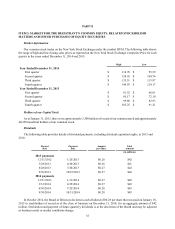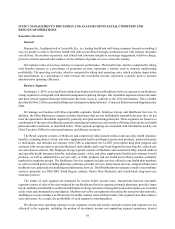Humana 2014 Annual Report Download - page 37
Download and view the complete annual report
Please find page 37 of the 2014 Humana annual report below. You can navigate through the pages in the report by either clicking on the pages listed below, or by using the keyword search tool below to find specific information within the annual report.29
strategy successfully, we must identify suitable candidates for and successfully complete transactions, some of which
may be large and complex, and manage post-closing issues such as the integration of acquired companies or employees.
Integration and other risks can be more pronounced for larger and more complicated transactions, transactions outside
of our core business space, or if multiple transactions are pursued simultaneously. The failure to successfully integrate
acquired entities and businesses or failure to produce results consistent with the financial model used in the analysis
of our acquisitions may have a material adverse effect on our results of operations, financial position, and cash flows.
If we fail to identify and complete successfully transactions that further our strategic objectives, we may be required
to expend resources to develop products and technology internally. In addition, from time to time, we evaluate
alternatives for our businesses that do not meet our strategic, growth or profitability objectives. Among the businesses
that we are currently evaluating is our closed block of long-term care insurance policies business. While no decision
has been made with respect to any course of action, if we were to divest this business it is reasonably likely that we
would have to recognize a material loss that will have a material adverse effect on our results of operations. The
divestiture of certain other businesses could also result, individually or in the aggregate, in the recognition of material
losses and a material adverse effect on our results of operations. There can be no assurance that we will be able to
complete any such divestitures on terms favorable to us.
If we fail to develop and maintain satisfactory relationships with the providers of care to our members, our
business may be adversely affected.
We employ or contract with physicians, hospitals and other providers to deliver health care to our members. Our
products encourage or require our customers to use these contracted providers. A key component of our integrated care
delivery strategy is to increase the number of providers who share medical cost risk with us or have financial incentives
to deliver quality medical services in a cost-effective manner.
In any particular market, providers could refuse to contract with us, demand higher payments, or take other actions
that could result in higher health care costs for us, less desirable products for customers and members or difficulty
meeting regulatory or accreditation requirements. In some markets, some providers, particularly hospitals, physician
specialty groups, physician/hospital organizations, or multi-specialty physician groups, may have significant market
positions and negotiating power. In addition, physician or practice management companies, which aggregate physician
practices for administrative efficiency and marketing leverage, may compete directly with us. If these providers refuse
to contract with us, use their market position to negotiate unfavorable contracts with us or place us at a competitive
disadvantage, or do not enter into contracts with us that encourage the delivery of quality medical services in a cost-
effective manner, our ability to market products or to be profitable in those areas may be adversely affected.
In some situations, we have contracts with individual or groups of primary care providers for an actuarially
determined, fixed fee per month to provide a basket of required medical services to our members. This type of contract
is referred to as a “capitation” contract. The inability of providers to properly manage costs under these capitation
arrangements can result in the financial instability of these providers and the termination of their relationship with us.
In addition, payment or other disputes between a primary care provider and specialists with whom the primary care
provider contracts can result in a disruption in the provision of services to our members or a reduction in the services
available to our members. The financial instability or failure of a primary care provider to pay other providers for
services rendered could lead those other providers to demand payment from us even though we have made our regular
fixed payments to the primary provider. There can be no assurance that providers with whom we contract will properly
manage the costs of services, maintain financial solvency or avoid disputes with other providers. Any of these events
may have a material adverse effect on the provision of services to our members and our results of operations, financial
position, and cash flows.
Our pharmacy business is highly competitive and subjects us to regulations in addition to those we face with
our core health benefits businesses.
Our pharmacy mail order business competes with locally owned drugstores, retail drugstore chains, supermarkets,
discount retailers, membership clubs, Internet companies and other mail-order and long-term care pharmacies. Our
pharmacy business also subjects us to extensive federal, state, and local regulation. The practice of pharmacy is generally







